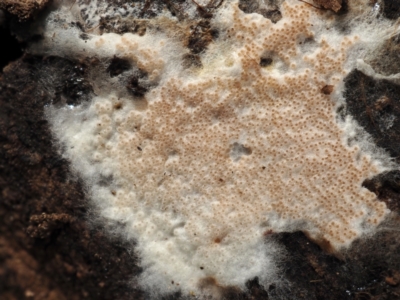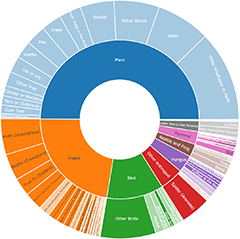Other non-black fungi
As the heading suggests, this subgroup holds a mixed-bag of on-wood leftovers. A few examples of what you find in this subgroup are:
Some polypores. Mostly these would be the flat or sheet-like polypores (technically resupinate polypores), commonly found on the lower surfaces of dead or live wood. There are also a few species that produce pendant fruitbodies (and most likely to be seen in the Canberra Nature Map area are the rusty-brown Coltriciella fruitbodies on the underside of rotting wood).
Corticioid fungi. Mostly these occur on the underside of dead wood lying on the ground, though a few are found on live wood. Mostly the fruitbody is fairly thin (often like a coat of paint or a skin on the wood) and many have featureless surfaces, so it is understandable to see them sometimes called paint fungi. However, the surface may be rough (e.g. warted, toothed, densely wrinkled), though the roughness is usually under a millimetre in depth. Furthermore, fruitbodies range from a thin and almost invisible wash to densely cobwebby to leathery in texture.
Septobasidium. The fruitbodies in this genus are brown, velvety patches that appear on branches of live plants. Though the fruitbodies appear on wood, the fungi parasitize scale insects and under a velvety Septobasidium patch you will find scale insects.
Announcements
There are currently no announcements.
Discussion
zzz puzzles on wood
zzz puzzles on wood
Your photos are a little blurry and I cannot tell whether any black lips are present or not. There are several other genera of such ‘black lips’ fungi, macroscopically similar and where identification depends on features of the sexual spores. Some years ago I collected a specimen of a different genus but one where similar ‘Coniopsorium’ lumps were present with the black lips. So, though I suspect that your fungus is a ‘Coniosporium’, I cannot say which black lips genus it might be associated with.
zzz puzzles on wood
zzz puzzles on wood
Top contributors
- trevorpreston 69
- Hejor1 32
- Heino1 18
- KenT 15
- CanberraFungiGroup 14
- TimL 12
- Heino 10
- Paul4K 8
- Teresa 6
- Caric 5
Top moderators
- Heino1 122
- Heinol 35
- Heino 16
- Teresa 6
- MichaelMulvaney 4
- CanberraFungiGroup 3
- Csteele4 2
- KenT 1
- Pam 1
- purple66 0






